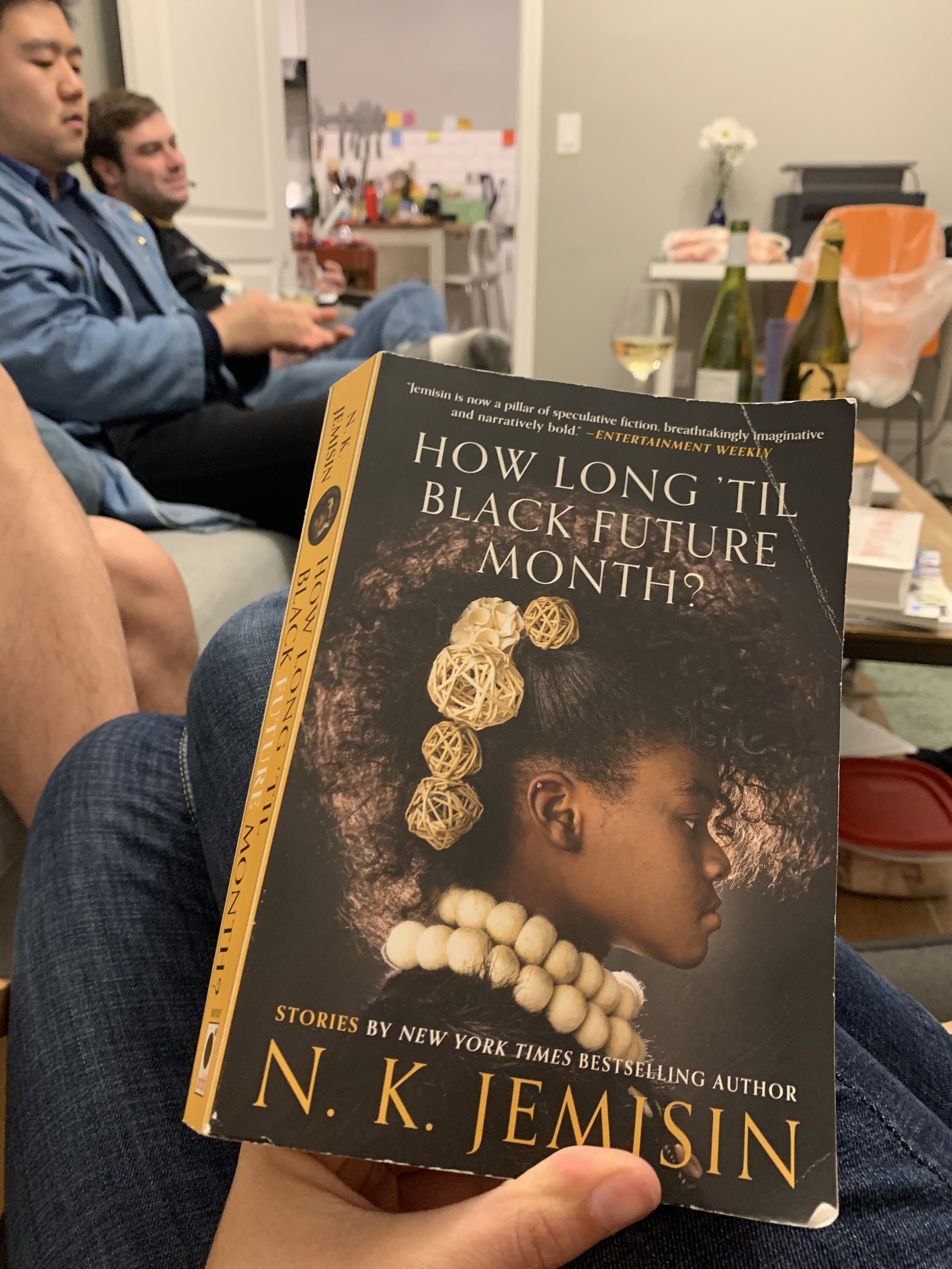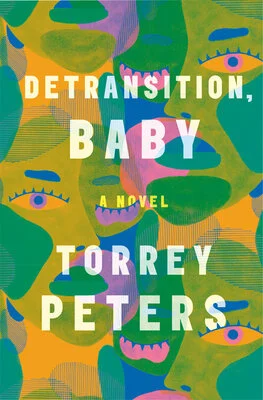How Long 'Til Black Future Month? by NK Jemisin
Title: How Long ‘Til Black Future Month?
Author: NK Jemisin
Published: 2018
Type: Fiction
Pages: 397
Everyone—even the poor, even the lazy, even the undesirable—can matter. Do you see how just the idea of this provokes utter rage in some? That is the infection defending itself … because if enough of us believe a thing is possible, then it becomes so.
In Brief:
Such a great short story collection! Jemisin displays an amazing range within sci-fi/fantasy, from aliens to steampunk to modern politics to AI and everything in between.
Rating: 4.6
Synopsis:
How Long ‘Til Black Future Month contains 22 science fiction stories -- it’s impossible for me to summarize them all. As I’ve already mentioned, they have an incredible range, all varying in subject, tone, and style. As fantastic as they are, Jemisin draws deft parallels and critiques of modern society, commenting boldly on race, gender, and class, as well as sci-fi as a genre.
All told, there were only a couple that I actively didn’t like, but for the sake of this section I’ll focus on three of my favorites:
“The Effluent Engine” is a steampunk story set in an alternate 19th-century New Orleans. Its protagonist, a lesbian spy named Jessaline from the newly-formed nation of Haiti, is on a mission to gain the expertise of a Creole scientist. She needs him to build a methane extraction system the Haitians can use to keep their place as the “foremost manufacturers of dirigibles in the Americas.” Along the way she falls in love with the scientist’s intelligent sister and must fight a secret society of white supremacists. All told, the story is very sexy, very cool.
“Sinners, Saints, Dragons, and Haints, in the City Beneath the Still Waters” also takes place in New Orleans, this time just after Hurricane Katrina. The protagonist is Tookie, left behind after he couldn’t fit into his family’s car, who looks after an old woman with the occasional help of a snarky, winged lizard. Meanwhile, there’s a mysterious darkness lurking in the waters that they must fight, a creature described as “like mean got a shape and gone walkin’ around, spreadin’ more mean everywhere it go.”
“Cuisine des Memoires” tells the story of two friends who go to dinner at an unusual restaurant. There, they can order “any meal from any occasion” in history, such as the final meal of Marie Antionette. One of the friends, Harold, is understandably suspicious and orders the meal prepared by his ex-wife the night he proposed. The magic of this story is the loving description of the meal – the precise details of the food, the way Harold is transported back in time. It’s less “magic” than some of the others, but tangible and relatable – the way I can eat shakshuka and be transported back to my semester abroad, or linguini and clams and feel myself in my grandparents’ kitchen.
Where I’m At:
I read this book during my last days of freedom, though I didn’t know it then. My roommate and I moved to a new apartment, leaving our one-bedroom space perched on the edge of the Tenderloin for a two-bedroom (plus a living room!) in the nicer (read: basic) Marina district, just near the water. I canvassed for Liz Warren before Super Tuesday, went to an “Anna of the North” concert. I watched the season finale of The Bachelor at my friend’s apartment, having inexplicably becoming hooked after years of disdain for the show and everything it stood for. We read this book for my regular Book Club, and it was the last in-person discussion we’ll have for the foreseeable future.
All pretty normal, boring things, but they feel far away and impossibly precious now, three weeks into San Francisco’s shelter in place. At the time I knew that it was likely something like this would happen – Biosecurity and Pandemic Preparedness is one of OP’s cause areas after all, and all my coworkers were talking about it. Everything felt ominous, anxious. So it was a welcome relief to read Jemisin’s rich, fantastical tales, to escape into another world entirely, imagine monsters and magic instead of this disease.
Getting Into it:
I haven’t read any of Jemisin’s novels, which is a mistake on my part. She’s the first African-American to win the Hugo Award for Best Science Fiction Novel, and the first writer in history to win it three times in a row. To be fair, I’m not typically the biggest fan of sci-fi, but Jemisin is a cultural force in the literary world.
Let me just wig out about the range again – I’m astonished that all these stories came from the brain of one woman. While waiting at my therapist’s office, I found an article about Jemisin where she explains many of her ideas come from her dreams. While that explains a bit, my dreams are nowhere near as fantastic nor sprawling as these stories. They absolutely pulse with vibrancy, lush creativity and gorgeous detail that could make me believe in cyborgs and witches. Many short story collections follow some kind of theme, or at least take place in the same world. Jemisin takes no such shortcuts.
Other than the creativity, what struck me the most was her skill building up the stories within a very short period of time. That’s the challenge with short stories, of course – I think they’re very difficult to do well, and when it does happen, it’s in some way more impressive than a novel. The author has a very short period to build a world and create characters and make the reader invested – this challenge is magnified in the sci-fi genre, when the world and its laws are entirely new. In most stories, Jemisin was marvelous at accomplishing this, often using dialogue to fill in the details rather than telling the reader in drawn-out expository. A few paragraphs in and I would be absolutely entranced.
There were a few stories that fell short. Occasionally, Jemisin would mess with the structure of the story – tell it out of order, or through emails/chats. Those didn’t work for me, just made the reading unnecessarily confusing and difficult to dive into. My only other criticism probably comes more from my dislike of the genre; I’m a sucker for fantasy and magic, but when science played too much of a role in the narrative I’d become rather lost and a bit disinterested.
Finally, this wouldn’t be complete without referencing the refreshing diversity Jemisin brings to the genre long-dominated by white men. The book is even named after an essay she wrote, where she critiques the sexism and racism in speculative fiction authors. Jemisin isn’t often overtly political in her stories,* because she doesn’t have to be. She focuses on black characters, weaves in black history, myths, and culture, and that’s radical enough.
I recommend this book really to anyone, even if you don’t typically enjoy the genre. Jemisin’s writing is unlike anything out there, and the stories are a welcome escape in these less-than-fantastic times.
* That said, there is a poignant moment where a character in the Jim Crow South has a vision of a man standing on the steps of the White House “brown as fig jam. And then a woman, black as molasses, her gaze hard and high and proud.” That made me feel nostalgic, but also hopeful.






